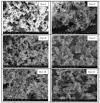Generation of Highly Antioxidant Submicron Particles from Myrtus communis Leaf Extract by Supercritical Antisolvent Extraction Process
- PMID: 36830088
- PMCID: PMC9951993
- DOI: 10.3390/antiox12020530
Generation of Highly Antioxidant Submicron Particles from Myrtus communis Leaf Extract by Supercritical Antisolvent Extraction Process
Abstract
Submicron particles have been produced from an ethanolic extract of Myrtus communnis leaves using supercritical carbon dioxide technology, hereinafter referred to as Supercritical Antisolvent Extraction (SAE). The influence of pressure (9-20 MPa), temperature (308 and 328 K) and injection rate (3 and 8 mL/min) on the particles' precipitation has been investigated, and it has been confirmed that increases in pressure and temperature led to smaller particle sizes. The obtained particles had a quasi-spherical shape with sizes ranging from 0.42 to 1.32 μm. Moreover, the bioactivity of the generated particles was assessed and large contents of phenolic compounds with a high antioxidant activity were measured. The particles were also subjected to in vitro studies against oxidative stress. The myrtle particles demonstrated cytoprotective properties when applied at low concentrations (1 μM) to macrophage cell lines.
Keywords: Myrtus communis; ROS; carbon dioxide; microparticles; supercritical antisolvent.
Conflict of interest statement
The authors declare no conflict of interest.
Figures








Similar articles
-
Preparation and physicochemical properties of vinblastine microparticles by supercritical antisolvent process.Int J Mol Sci. 2012 Oct 3;13(10):12598-607. doi: 10.3390/ijms131012598. Int J Mol Sci. 2012. PMID: 23202916 Free PMC article.
-
Antioxidative properties and ability of phenolic compounds of Myrtus communis leaves to counteract in vitro LDL and phospholipid aqueous dispersion oxidation.J Food Sci. 2014 Jul;79(7):C1260-70. doi: 10.1111/1750-3841.12517. Epub 2014 Jun 24. J Food Sci. 2014. PMID: 24962212
-
Phytochemical analysis of Myrtus communis plant: Conventional versus microwave assisted-extraction procedures.J Complement Integr Med. 2017 Jun 10;14(4):/j/jcim.2017.14.issue-4/jcim-2016-0098/jcim-2016-0098.xml. doi: 10.1515/jcim-2016-0098. J Complement Integr Med. 2017. PMID: 28731316
-
Green Processing of Ilex guayusa: Antioxidant Concentration and Caffeine Reduction Using Encapsulation by Supercritical Antisolvent Process.Molecules. 2024 Nov 11;29(22):5309. doi: 10.3390/molecules29225309. Molecules. 2024. PMID: 39598698 Free PMC article.
-
Nanoparticles in the pharmaceutical industry and the use of supercritical fluid technologies for nanoparticle production.Curr Drug Deliv. 2012 May;9(3):269-84. doi: 10.2174/156720112800389052. Curr Drug Deliv. 2012. PMID: 22283656 Review.
Cited by
-
Supercritical Impregnation of Mangifera indica Leaves Extracts into Porous Conductive PLGA-PEDOT Scaffolds.Polymers (Basel). 2023 Dec 30;16(1):133. doi: 10.3390/polym16010133. Polymers (Basel). 2023. PMID: 38201798 Free PMC article.
-
Encapsulation of Olive (Olea europaea L.) Pruning Waste Particles by Supercritical CO2 Technology.Foods. 2024 Mar 16;13(6):905. doi: 10.3390/foods13060905. Foods. 2024. PMID: 38540895 Free PMC article.
References
-
- Aidi Wannes W., Mhamdi B., Sriti J., Ben Jemia M., Ouchikh O., Hamdaoui G., Kchouk M.E., Marzouk B. Antioxidant Activities of the Essential Oils and Methanol Extracts from Myrtle (Myrtus Communis Var. Italica L.) Leaf, Stem and Flower. Food Chem. Toxicol. 2010;48:1362–1370. doi: 10.1016/j.fct.2010.03.002. - DOI - PubMed
-
- Krishnaiah D., Sarbatly R., Nithyanandam R. A Review of the Antioxidant Potential of Medicinal Plant Species. Food Bioprod. Process. 2011;89:217–233. doi: 10.1016/j.fbp.2010.04.008. - DOI
Grants and funding
LinkOut - more resources
Full Text Sources

